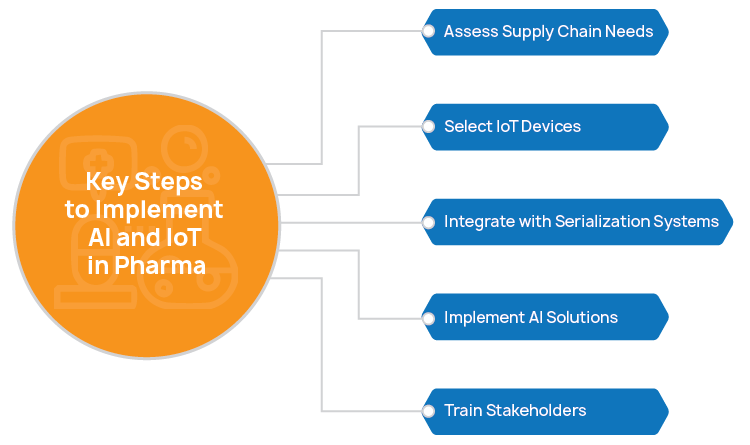

ACL Digital
5 Minutes read
Transforming Pharma Logistics with AI and IoT
The pharmaceutical industry operates under high stakes—where the quality, safety, and availability of medications can directly impact patient lives. Ensuring that pharmaceutical products remain effective, authentic, and accessible requires a robust, transparent, and intelligent supply chain. This is where the combination of Artificial Intelligence (AI) and the Internet of Things (IoT) is making transformative strides.
By integrating IoT-enabled devices for real-time data collection and AI for advanced analytics, pharma companies can move from reactive problem-solving to proactive decision-making. From cold chain logistics to intelligent packaging, AI and IoT technologies are revolutionizing how medicines are manufactured, tracked, and delivered.
Real-Time Monitoring in Cold Chains and Serialization with IoT Devices
Pharmaceutical products, especially vaccines and biologics, are extremely temperature-sensitive. A deviation of just a few degrees during storage or transit can render them ineffective. Traditional monitoring methods often fall short in providing continuous oversight, leaving room for error. IoT-enabled devices fill this gap by offering real-time tracking and alerts.
IoT in Cold Chain Monitoring
IoT sensors monitor critical environmental parameters such as temperature, humidity, and light exposure. These sensors are placed within shipping containers or storage units and are configured to trigger alerts if pre-set thresholds are breached. This allows logistics teams to intervene immediately and prevent spoilage.
Cloud connectivity ensures that this data is transmitted continuously, stored securely, and analyzed in real time. This not only helps maintain compliance with stringent regulations but also provides a complete audit trail for inspections and quality checks.
IoT in Serialization
Serialization is a key element of track-and-trace protocols designed to combat counterfeit drugs. With Automated Labelling System, serialization could be possible. IoT plays a significant role here by automating the capture and transmission of product identifiers (such as barcodes or RFID tags) at every point in the supply chain. This enables end-to-end visibility and verification of each product’s journey. For example, A global vaccine distributor used IoT sensors to monitor temperature conditions throughout transit. Immediate alerts on deviations allowed corrective actions, avoiding product wastage and saving millions in losses.
AI for Predictive Analytics and Anomaly Detection in Supply Chains
While IoT provides the data, AI makes sense of it. AI’s ability to process vast volumes of information and detect patterns brings a strategic layer of intelligence to pharma supply chains.
AI in Predictive Analytics
Predictive models trained on historical and real-time data can forecast demand, helping companies maintain optimal inventory levels and reduce stockouts or overproduction. Similarly, AI can be used for predictive maintenance—analyzing usage patterns and operational parameters of machinery to anticipate and prevent breakdowns.
This leads to increased uptime, lower operational costs, and improved planning across the entire supply chain.
AI in Anomaly Detection
AI algorithms excel at identifying outliers and unusual patterns. This capability is invaluable for detecting issues like shipment delays, route deviations, or signs of counterfeiting. Early anomaly detection enables swift corrective measures, safeguarding both product integrity and patient health. For instance, A pharmaceutical manufacturer implemented AI-powered analytics to fine-tune production schedules, resulting in a 20% improvement in operational efficiency and significant cost savings.
Use Cases for IoT and AI in Healthcare Packaging & Supply Chain
The evolution of smart packaging has opened new avenues for AI and IoT in the pharmaceutical sector. These technologies are now embedded in packaging solutions to offer transparency, traceability, and enhanced user engagement.
Real-Time Shipment Monitoring
Traditionally, tracking a shipment involved scanning labels at multiple checkpoints. However, this leaves gaps in the supply chain and doesn’t offer real-time location updates. With IoT-enabled tags such as RFID or GPS trackers, companies can now monitor a shipment’s status and location throughout its entire journey.
Demand Forecasting
AI enhances demand forecasting by analyzing large datasets from search trends and social media to purchase history and economic indicators. This helps businesses adapt quickly to market changes and make more accurate inventory and production decisions.
Pricing Optimization
AI enables dynamic and personalized pricing by monitoring competitor activity, customer behavior, and market shifts. It also optimizes promotional strategies to increase revenue and boost customer engagement.
Inventory Management
Using predictive analytics, AI helps maintain optimal inventory levels, determine reorder points, and tailor stock strategies based on customer behavior, reducing overstocking and stockouts.
Route Optimization
AI processes real-time data from GPS, weather, and traffic systems to dynamically adjust delivery routes. This is especially critical in cold chain logistics to maintain product quality and reduce delays.
Supply Chain Visibility
AI integrates data from multiple sources orders, freight, and customer feedback to provide end-to-end visibility. It detects disruptions early and suggests optimal responses to maintain smooth operations.
Detecting Damage or Tampering
AI-enhanced IoT sensors embedded within packaging or transport vehicles can detect external threats like temperature breaches, vibration, or light exposure that might indicate tampering or damage. These sensors can also learn patterns that suggest package tampering, such as repeated openings or unexpected movements. If tampering is detected, delivery can be halted or products can be flagged for inspection, protecting both the brand and patient safety.
Connecting Products and People
Smart packaging also improves the patient experience. QR codes or NFC tags can provide patients with instant access to dosage instructions, side effect warnings, and drug interaction information. This improves adherence and reduces the risk of medication errors. Blockchain technology can also be integrated for immutable and transparent tracking of pharmaceutical products. This ensures that every stakeholder from manufacturer to patient has access to verified information about a product’s origin, movement, and handling.
Key Steps to Implement AI and IoT in Pharma
A strategic and phased approach ensures the successful integration of AI and IoT in pharmaceutical operations.
Assess Supply Chain Needs
Evaluate your current infrastructure and identify pain points where real-time visibility or predictive insights would add value.
Select IoT Devices
Choose sensors suited for your needs—temperature, humidity, pressure, GPS, or tamper detection sensors, depending on the product requirements.
Implement AI Solutions
Deploy machine learning models for demand forecasting, predictive maintenance, and anomaly detection across the supply chain.
Integrate with Serialization Systems
Ensure seamless data flow between AI/IoT platforms and existing serialization systems for end-to-end traceability.
Train Stakeholders
Provide comprehensive training to internal teams and external partners to ensure adoption and proper use of new technologies.

Key Benefits of IoT and AI in Smart Pharma Supply Chains
Improved Supply Chain Visibility
With end-to-end tracking from manufacturing to delivery, companies gain real-time insights into the movement and condition of every product. This transparency is crucial for compliance with regulations like HIPAA and for optimizing supplier performance.
Reduced Costs
Proactive monitoring helps detect issues before they become costly problems. Whether it’s avoiding spoilage or preventing counterfeit distribution, real-time alerts allow companies to mitigate losses and hold vendors accountable.
Enhanced Patient Safety
Ultimately, the most significant impact is on patient outcomes. Ensuring medications are safely delivered, properly stored, and not tampered with can prevent adverse effects and even save lives. Additionally, real-time data from connected devices can support faster emergency response, improving treatment effectiveness.
Conclusion
AI and IoT are no longer futuristic concepts; they have become essential tools for building smart, secure, and efficient pharmaceutical supply chains. From real-time monitoring and predictive analytics to intelligent packaging and blockchain-based traceability, these technologies are transforming how life-saving medications are manufactured and delivered.
At ACL Digital, we offer comprehensive IoT solution engineering services to design, develop, integrate customized solutions and modernize legacy devices. As the pharmaceutical landscape continues to evolve, adopting Artificial Intelligence and IoT technologies will be crucial to staying competitive, ensuring compliance, and—most importantly—delivering patient-centric care.





